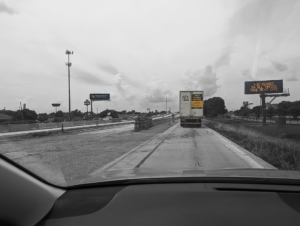Large commercial vehicles fill our roads. Driving alongside them can be scary when 18-wheelers can weigh 40 tons and move at 65 mph or more. You wonder if they even see you in your car or smaller truck. Sometimes they cannot. Big trucks have large blind spots. You can drive better and safer if you know where those blind spots are and how to avoid them.
Use These Easy Tips to Avoid Big Truck Blind Spots
Eighteen-wheelers have four blind spots, one on each side. Each of these is big enough to hide one or more passenger vehicles. In order to drive safely, you need to know where the blind spots are, how to avoid them, and what to do when you inevitably have to be inside one.
FAQ #1: How Big Are Blind Spots?
Blind spots on commercial vehicles are quite large. The areas in front and to the left of the truck can easily hold a passenger vehicle. In the back and behind the truck, the blind spot is big enough to cover several passenger vehicles. As a rule, avoid driving too close to a commercial vehicle.
| 18-Wheeler Blind Spot | Size of Truck’s Blind Spot |
| Right | 2 traffic lanes |
| Left | 1 traffic lane |
| Front | Around 20 feet |
| Back | Around 30-200 feet |
FAQ #2: What Is the Front Blind Spot?
A zone shaped like a box extending 20 feet in front of the truck is the front blind spot. Never pull directly in front of a truck. Not only will the driver have difficulty braking if you cannot maintain a higher speed, but the driver may not see you at all. When pulling into a lane in front of a truck, always give at least that amount of space. Remember, trucks take 40% longer to stop.
FAQ #3: What Is the Back Blind Spot?
Commercial trucks do not have rear view mirrors. The truck’s trailer would block these mirrors. Drivers must rely on their side-view mirrors to see the surrounding traffic. This creates a big blind spot behind a truck.
Totally avoid driving 30 feet behind the truck. If you are traveling behind a truck, give it 200 feet of road space between you for maximum safety. This distance also improves your vision of the road, as the truck won’t be blocking your view of signs or hazards ahead.
FAQ #4: What Is the Right Blind Spot?
The right-side blind spot is very large. It extends diagonally in a wing-like shape from the side of the cabin, across two lanes, with its tip ending near the end of the back blind spot. The driver can see some directly along the side of the truck with their mirrors, but enter that spot with caution.
The right blind spot makes it so important not to pass a truck on the right or even hang out on the right side of a truck. Fortunately, most truck drivers gwill stay in the right lane unless passing. However, not all follow that guidance.
FAQ #5: What Is the Left Blind Spot?
The left-side blind spot is relatively small. It covers one lane, reaching out from the side of the cabin. It has a small wing-point that reaches back to the front of the cargo and then leaves the road or enters another lane. After that, the mirrors allow the driver to see well.
Your car or small truck has a similar blind spot you can see for yourself. The best way to monitor it is to know what moves into it and what moves out of it. If you know these, then you know what is in the blind spot.
FAQ #6: How Do I Avoid Blind Spots?
Avoid driving too close to the truck in any direction unless you are hurrying through the blind spot. Look at the truck’s mirrors. If you can see the driver in the mirror, then the driver can see you. The longer you stay in spots where the driver cannot see you, the more likely a crash becomes.
FAQ #7: How Do I Pass a Commercial Vehicle?
Start from a position where the 18-wheeler can see you — outside the blind spots. Signal early to let the truck know your intentions. Avoid passing on the right side of the truck. That side has the largest blind spot and the biggest potential for an accident. Pass quickly through the left blind spot. Make sure you maintain speed as you pull in front of the truck by at least two car lengths. As long as you are still moving faster than the truck, you can slow down after that.
FAQ #9: What About Louisiana?
In Louisiana, you can sue the driver if their negligence hurts you. You may also be able to sue the trucking company. Louisiana Civil Code 2330 sets up the law of vicarious liability. You can sue the trucking company:
- If the driver acted negligently
- And they were on the clock for their employer at the time of the accident
- And you suffered physical and financial losses
You can sue for current and future medical costs related to the injury, current and future lost income and benefits, diminished earning capacity, damage to your vehicle, and more.
FAQ #8: What About Texas?
Texas also has vicarious liability. If your accident meets the conditions to qualify, you can sue the trucking company as well as the driver.
Four thousand people died in car accidents in Texas in 2021. Of that number, 700 died from collisions with commercial vehicles. That year there were 38,000 commercial vehicle crashes. So the fatality rate is low, but it should be lower.
If an accident injured you or a loved one in a blind spot, talk to an attorney. You might recoup your medical expenses and more.
Keep a respectful distance from trucks, especially on its right side. Know where its blind spots are, and avoid lingering in those places. If you need to pass a truck, pass with care on the left side. You and your passengers will be safer and happier if you understand blind spots and use your knowledge about them.
Works Cited
American Automobile Association. “How to Stay out of a Truck’s Blind Spots.” July 18, 2022. https://www.wikihow.com/Stay-Out-of-a-Truck%27s-Blind-Spots
FMCSA. “Our Roads Our Responsibility.” https://www.fmcsa.dot.gov/sites/fmcsa.dot.gov/files/docs/lang/USDOT_OROR_Inforgraphic_1170x612-Truck_V17ai.pdf
Louisiana CC 2320 https://www.legis.la.gov/legis/Law.aspx?d=109383
Texas Department of Transportation. “Comparison of Motor Vehicle Traffic Deaths, Vehicle Miles, Death Rates, and Economic Loss 2003-2021.” https://ftp.txdot.gov/pub/txdot-info/trf/crash_statistics/2021/a.pdf
Texas Department of Transportation. “Commercial Motor Vehicle Involved Crashes by County.” https://ftp.txdot.gov/pub/txdot-info/trf/crash_statistics/2021/30.pdf









